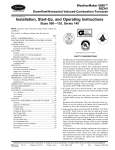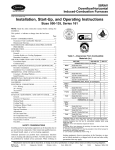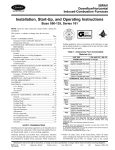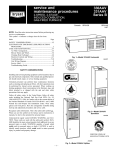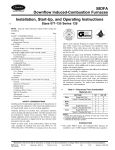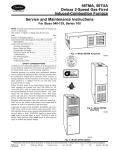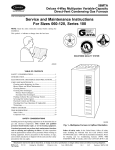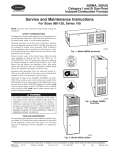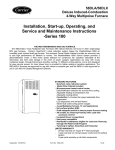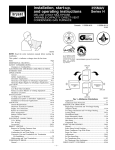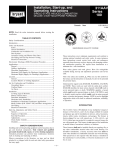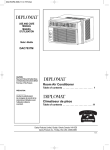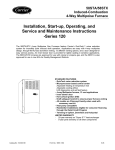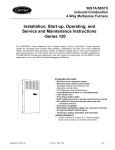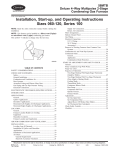Download Carrier 58TMA Furnace User Manual
Transcript
Visit www.carrier.com 58TMA Downflow/Horizontal 2-Speed, 2-Stage, Induced-Combustion Gas Furnace Installation, Start-Up, and Operating Instructions Sizes 065-125, Series 111 NOTE: Read the entire instruction manual before starting the installation. This symbol → indicates a change since the last issue. Index ama Page SAFETY CONSIDERATIONS .....................................................1 ELECTROSTATIC DISCHARGE (ESD) PRECAUTIONS PROCEDURE ...........................................................................2 INTRODUCTION.......................................................................2-4 Dimensional Drawing ....................................................................2 Clearances to Combustibles......................................................3 LOCATION....................................................................................4 General ......................................................................................4 Location Relative to Cooling Equipment ................................4 Hazardous Locations.................................................................4 AIR FOR COMBUSTION AND VENTILATION...................4-5 Unconfined Space .....................................................................4 Confined Space......................................................................4-5 SUPPLY-AIR PLENUM INSTALLATION (DOWNFLOW) .....................................................................5-6 Installation On Combustible Floor...........................................6 HORIZONTAL ATTIC INSTALLATION...................................7 HORIZONTAL CRAWLSPACE INSTALLATION....................7 FILTER ARRANGEMENT...........................................................7 GAS PIPING...............................................................................7-9 ELECTRICAL CONNECTIONS ................................................10 115-v Wiring...........................................................................10 24-v Wiring.............................................................................10 Accessories..............................................................................10 VENTING ....................................................................................10 START-UP, ADJUSTMENT, AND SAFETY CHECK.......10-22 General...............................................................................10-12 Sequence of Operation ......................................................12-16 Adaptive Heating Mode ....................................................12-14 Non-Adaptive Heating Mode .................................................14 Cooling Mode ....................................................................14-15 Continuous Blower Mode.......................................................15 Heat Pump Mode ....................................................................15 Defrost Mode.....................................................................15-16 Start-Up Procedures ................................................................16 Adjustments .......................................................................16-22 Set Gas Input Rate ............................................................16-22 Set Temperature Rise ........................................................17-21 Set Thermostat Heat Anticipator ......................................21-22 Check Safety Controls ............................................................22 Checklist..................................................................................23 CANADIAN GAS ASSOCIATION ® R A PP R O VED CERTIFICATION OF MANUFACTURING SITE SAFETY CONSIDERATIONS Installing and servicing heating equipment can be hazardous due to gas and electrical components. Only trained and qualified personnel should install, repair, or service heating equipment. Untrained personnel can perform basic maintenance functions such as cleaning and replacing air filters. All other operations must be performed by trained service personnel. When working on heating equipment, observe precautions in the literature, on tags, and on labels attached to or shipped with the unit and other safety precautions that may apply. Follow all safety codes. In the United States, refer to the National Fuel Gas Code (NFGC) NFPA No. 54-1996/ANSI Z223.1-1996. In Canada, refer to the current edition of the National Standard of Canada CAN/CGA-B149.1- and .2-M95 Natural Gas and Propane Installation Codes (NSCNGPIC). Wear safety glasses and work gloves. Have fire extinguisher available during start-up and adjustment procedures and service calls. Recognize safety information. This is the safety-alert symbol . When you see this symbol on the unit and in instructions or manuals, be alert to the potential for personal injury. Understand the signal words DANGER, WARNING, and CAUTION. These words are used with the safety-alert symbol. DANGER identifies the most serious hazards which will result in severe personal injury or death. WARNING signifies hazards which could result in personal injury or death. CAUTION is used to identify unsafe practices which would result in minor personal injury or product and property damage. These instructions cover minimum requirements and conform to existing national standards and safety codes. In some instances, these instructions exceed certain local codes and ordinances, especially those that may not have kept up with changing residential construction practices. We require these instructions as a minimum for a safe installation. Manufacturer reserves the right to discontinue, or change at any time, specifications or designs without notice and without incurring obligations. Book 1 4 PC 101 Catalog No. 535-887 Printed in U.S.A. Form 58TMA-6SI Pg 1 8-97 Replaces: 58TMA-4SI Tab 6a 8a 28 1⁄2″ VENT CONNECTION 20″ 13⁄16″ INLET D 13⁄16″ 4 3⁄16″ 2 15⁄16″ 39 7⁄8″ 7⁄8″ DIA ACCESSORY 1 3⁄4″ DIA HOLE GAS ENTRY 11⁄16″ OUTLET 19″ 7⁄8″ DIA ACCESSORY 7⁄8″ DIA HOLE POWER ENTRY 1 1⁄2″ DIA R.H. GAS ENTRY 9 1⁄8″ 16 1⁄16″ 10 1⁄4″ 1 1⁄16″ 2 1⁄8″ 8 1⁄4″ 13 5 ⁄16″ 10 1⁄4″ 11⁄16″ E A 11⁄16″ NOTE: ADDITIONAL 7⁄8″ DIA K.O. ARE LOCATED IN THE TOP PLATE AND BOTTOM PLATE 1⁄2″ DIA THERMOSTAT WIRE ENTRY 2″ 7⁄8″ DIA ACCESSORY 1″ TYP 5⁄8″ TYP 1 1⁄16″ 2 1 ⁄8 ″ AIRFLOW DIMPLES TO DRILL HOLES FOR HANGER BOLTS (4 PLACES) IN HORIZONTAL POSITION A88324 Fig. 1—Dimensional Drawing Table 1—Dimensions (In.) UNIT SIZE 065-08 065-12 085-12 085-16 105-16 105-20 125-20 A 14-3/16 14-3/16 17-1/2 17-1/2 17-1/2 21 24-1/2 D 12-9/16 12-9/16 15-7/8 15-7/8 15-7/8 19-3/8 22-7/8 E 12-11/16 12-11/16 16 16 16 19-1/2 23 ELECTROSTATIC DISCHARGE (ESD) PRECAUTIONS PROCEDURE VENT CONN 4 4 4 4 4 4 5 SHIP. WT 141 145 154 154 171 181 192 5. Use this procedure for installed and uninstalled (ungrounded) furnaces. 6. Before removing a new control from its container, discharge your body’s electrostatic charge to ground to protect the control from damage. If the control is to be installed in a furnace, follow items 1 through 5 before bringing the control or yourself into contact with the furnace. Put all used AND new controls into containers before touching ungrounded objects. Electrostatic discharge can affect electronic components. Take precautions during furnace installation and servicing to protect the furnace electronic control. Precautions will prevent electrostatic discharges from personnel and hand tools which are held during the procedure. These precautions will help to avoid exposing the control to electrostatic discharge by putting the furnace, the control, and the person at the same electrostatic potential. 7. An ESD service kit (available from commercial sources) may also be used to prevent ESD damage. → 1. Disconnect all power to the furnace. DO NOT TOUCH THE CONTROL OR ANY WIRE CONNECTED TO THE CONTROL PRIOR TO DISCHARGING YOUR BODY’S ELECTROSTATIC CHARGE TO GROUND. INTRODUCTION The model 58TMA Series 111 Furnace is available in sizes 65,000 through 123,000 Btuh input capacities. The design of the downflow/horizontal gas-fired furnace is A.G.A./C.G.A. certified for natural and propane gases and for installation on noncombustible flooring. The furnace is factoryshipped for use with natural gas. The manufacturer’s accessory gas conversion kit is required to convert furnace for use with propane gas. 2. Firmly touch a clean, unpainted, metal surface of the furnace chassis which is close to the control. Tools held in a person’s hand during grounding will be satisfactorily discharged. 3. After touching the chassis you may proceed to service the control or connecting wires as long as you do nothing that recharges your body with static electricity (for example; DO NOT move or shuffle your feet, DO NOT touch ungrounded objects, etc.). These furnaces SHALL NOT be installed directly on carpeting, tile, or any other combustible material other than wood flooring. In downflow installations, the manufacturer’s accessory floor base must be used when installed on combustible materials and wood flooring. Special base is not required when this furnace is installed on manufacturer’s Coil Assembly Part No. CD5 or CK5, or when Coil Box Part No. KCAKC is used. This furnace is for installation 4. If you touch ungrounded objects (recharge your body with static electricity), firmly touch furnace again before touching control or wires. 2 MINIMUM INCHES CLEARANCE TO COMBUSTIBLE CONSTRUCTION Clearance arrows do not change with furnace orientation. 1" BA C K F † → AC FR * 1" # Clearance in inches. FR ON O S N Vent Clearance to combustibles: *# T T ## BOTTOM S E ID SI E "# * N UR †1 For installation on non-combustible floors only. For installation on combustible flooring only when installed on special base, Part No. KGASB0201ALL, Coil Assembly, Part No. CD5 or CK5, or Coil Casing, Part No. KCAKC. # For furnaces wider than 14.25 inches (362mm) may be 0 inches. Ø 18 inches front clearance required for alcove. Indicates supply or return sides when furnace is in the horizontal position. Line contact only permissible between lines formed by intersections of the Top and two Sides of the furnace jacket, and building joists, studs or framing. ## For single wall vent type 6 inches. For Type B-1 vent type 3 inches. †† Clearance to Back 0 inches (0 po) in downflow and horizontal (attic/alcove & crawlspace) positions and 3 inches (3 po) in horizontal closet positions. 1" DE For Single Wall vents 6 inches (6 po). For Type B-1 vent type 1 inch (1 po). E RV IC E 30" MIN Ø 322286-101 REV. D (LIT) 0"†† TOP / PLENUM This forced air furnace is equipped for use with natural gas at altitudes 0-10,000 ft (0-3,050m). An accessory kit, supplied by the manufacturer,shall be used to convert to propane gas use or may be required for some natural gas applications. This furnace is for indoor installation in a building constructed on site. This furnace may be installed on combustible flooring in alcove or closet at minimum clearance from combustible material. This furnace may be used with a Type B-1 Vent and may be vented in common with other gas-fired appliances. A97430 Fig. 2—Clearances to Combustibles in alcoves, attics, crawlspaces, basements, closets, or utility rooms. The design of this furnace line is not A.G.A./C.G.A. certified for installation in mobile homes, recreation vehicles, or outdoors. Before installing the furnace, refer to the current edition of the NFGC and the NFPA 90B. Canadian installations must be installed in accordance NSCNGPIC and all authorities having jurisdiction. For a copy of the NFGC NFPA54/Z223.1, contact International Approval Services U.S. Inc., 8501 E. Pleasant Valley Road, Cleveland, OH 44131 or National Fire Protection Association Inc., Batterymarch Park, Quincy, MA 02269. For a copy of NFPA 90B, contact National Fire Protection Association Inc., Batterymarch Park, Quincy, MA 02269. Before installing the furnace in Canada, refer to the current edition of the NSCNGPIC. Contact Standards Department of Canadian Gas Association, 55 Scarsdale Road, Don Mills, Ontario, Canada M3B 2R3. The duct system should be designed and sized according to accepted national standards published by: Air Conditioning Contractors Association (ACCA), Sheet Metal and Air Conditioning Contractors National Association (SMACNA). Or consult the Residential Systems Design Guidelines reference tables available from your local distributor. The duct system should be sized to handle the maximum CFM capabilities of the equipment at the optimum design static pressure. Application of this furnace should be indoors with special attention given to vent sizing and material, gas input rate, air temperature rise, and unit sizing. Improper installation or misapplication of the furnace can require excessive servicing or cause premature component failure. Installation must conform to regulations of serving gas supplier and local building, heating, and plumbing codes in effect in the area in which installation is made, or in absence of local codes with requirements of the NFGC. This furnace is designed for a minimum continuous return-air temperature of 60°F db or intermittent operation down to 55°F such as when used with a night setback thermostat. Return-air temperature must not exceed 85°F db. To aid in installation, troubleshooting, and service, a status code label is located on blower component door. This label explains how to use the LED status indicated on furnace control which is viewed through the sight glass on door. 3 HAZARDOUS LOCATIONS When furnace is installed in a residential garage, it must be installed so that burners and ignition source are at least 18 in. above floor. The furnace should be protected from physical damage by vehicles. Improper installation, adjustment, alteration, service, maintenance, or use can cause carbon monoxide poisoning, explosion, fire, electrical shock, or other conditions which may cause personal injury, loss of life, or property damage. Consult a qualified installer, service agency, local gas supplier, or your distributor or branch for information or assistance. The qualified installer or agency must use only factory-authorized and listed kits or accessories when modifying this product. A failure to follow this warning could result in electrical shock, fire, personal injury, or death. When furnace is installed in public garages, airplane hangars, or other buildings having hazardous atmospheres, unit must be installed in accordance with recommended good practice requirements of the National Fire Protection Association, Inc. → Step 2—Air for Combustion and Ventilation Provisions for adequate combustion and ventilation air must be provided in accordance with Section 5.3, Air for Combustion and Ventilation, of the NFGC or applicable provisions of local building codes. For high-altitude installation, the high-altitude conversion kit must be installed at or above 5500 ft above sea level. For accessory installation details, refer to applicable installation literature. Canadian installations must be in accordance with NSCNGPIC and all authorities having jurisdiction. NOTE: Remove all shipping brackets and materials before operating furnace. Step 1—Location Air for combustion must not be contaminated by halogen compounds which include fluoride, chloride, bromide, and iodide. These elements are found in aerosol sprays, detergents, bleaches, cleaning solvents, salts, air fresheners, and other household products. GENERAL DO NOT install furnace in a corrosive or contaminated atmosphere. Make sure all combustion and circulating air requirements are followed. DO NOT use this furnace during construction when adhesives, sealers, and/or new carpets are being installed and curing. If the furnace is required during construction, use clean outside air for combustion and ventilation. Compounds of chlorine and fluorine when burned in combustion air form acids which will cause corrosion of the heat exchangers and metal vent systems. Some of these compounds are released from paneling and dry wall adhesives, paints, thinners, masonry cleaning materials, and many other solvents commonly used in the construction process. Excessive exposure to contaminated combustion air will result in safety and performance related problems. The operation of exhaust fans, kitchen ventilation fans, clothes dryers, or fireplaces could create a negative air pressure condition at the furnace. Make-up air must be provided for these devices, in addition to that required by the furnace. All fuel-burning equipment must be supplied with air for combustion of the fuel. Sufficient air MUST be provided to ensure there will not be a negative pressure in equipment room or space. In addition, a positive seal MUST be made between furnace cabinet and return-air duct to avoid pulling air from the burner area and draft safeguard opening into circulating air. The requirements for combustion and ventilation air depend upon whether furnace is located in a CONFINED or UNCONFINED space. This furnace must be installed so electrical components are protected from water. Locate furnace as near to center of air distribution system and chimney or vent as possible. The furnace should be installed as level as possible. UNCONFINED SPACE An unconfined space must have at least 50 cu ft for each 1000 Btuh of input for all appliances (such as furnaces, clothes dryer, water heaters, etc.) in the space. When furnace is installed so that supply ducts carry air to areas outside space containing furnace, the return air must also be handled by a duct(s) sealed to furnace casing and terminating outside space containing furnace. For Example: 58TMA FURNACE HIGH-FIRE INPUT BTUH 63,000 84,000 105,000 123,000 Provide ample space for servicing and cleaning. Always comply with minimum fire protection clearances shown on unit clearance label. This furnace shall not be installed directly on carpeting, tile, or any combustible material other than wood flooring. The furnace may be installed on combustible flooring when installed with accessory downflow subbase, which is available from your distributor or branch when required. MINIMUM SQ FT WITH 7-1/2 FT CEILING 420 560 700 820 If space is constructed unusually tight, air for combustion and ventilation MUST come from either the outdoors or spaces freely communicating with outdoors. Combustion and ventilation openings must be sized the same as for a confined space as defined below. Return air must not be taken from the room unless equal or greater amount of air is supplied to the room. LOCATION RELATIVE TO COOLING EQUIPMENT The cooling coil must be installed parallel with or on downstream side of furnace to avoid condensation in heat exchangers. When installed parallel with furnace, dampers or other means used to control the flow of air must prevent chilled air from entering furnace. If dampers are manually operated, they must be equipped with means to prevent operation of either unit unless damper is in full-heat or full-cooling position. CONFINED SPACE A confined space is defined as a space whose volume is less than 50 cu ft per 1000 Btuh of total input ratings of all appliances 4 DUCTS TO OUTDOORS 1 SQ IN. PER 4000 BTUH* VENT THROUGH ROOF (CATEGORY I) 12″ MAX INTERIOR HEATED SPACE 12″ MAX 1 SQ IN. PER 1000 BTUH* IN DOOR OR WALL UNCONFINED SPACE 6″ MIN (FRONT) † D ROOF (CATEGORY I) DUCTS TO OUTSIDE 1 SQ IN. PER 2000 BTUH* 1 SQ IN. PER 1000 BTUH* IN DOOR OR WALL 12″ MAX 12″ MAX SUPPLY AIR SUPPLY AIR 12″ MAX A RETURN VENT AIR THROUGH F 1 SQ IN. PER 4000 BTUH* CONFINED SPACE RETURN AIR 1 SQ IN. PER 2000 BTUH* E B OUTDOORS 1 SQ IN. PER 4000 BTUH* G 12″ MAX C 12″ MAX DUCT TO OUTDOORS 1 SQ IN. PER 4000 BTUH *Minimum dimensions of 3 in. NOTE: Use any of the following combinations of openings: A&B C&D D&E F&G * Minimum opening size is 100 sq in. with minimum dimensions of 3 in. † Minimum of 3 in. when type B-1 vent is used. A93387 A93388 Fig. 3—Confined Space: Air for Combustion and Ventilation from an Unconfined Space Fig. 4—Confined Space: Air for Combustion and Ventilation from Outdoors installed in that space. A confined space MUST have provisions for supplying air for combustion, ventilation, and dilution of flue gases using 1 of the following methods. (See Fig. 3 and Table 2.) 2. Air from outside the structure requires 1 of the following methods: a. If combustion air is taken from outdoors through 2 vertical ducts, the openings and ducts MUST have at least 1 sq in. of free area per 4000 Btuh of total input for all equipment within the confined space. (See Fig. 4 and Table 2.) b. If combustion air is taken from outdoors through 2 horizontal ducts, the openings and ducts MUST have at least 1 sq in. of free area per 2000 Btuh of total input for all equipment within the confined space. (See Fig. 4 and Table 2.) c. If combustion air is taken from outdoors through a single opening or duct (horizontal or vertical) commencing within 12 in. of the top of the confined space, opening and duct MUST have at least 1 sq in. of free area per 3000 Btuh of the total input for all equipment within the confined space and not less than the sum of the areas of all vent connectors in the confined space. (See Fig. 4 and Table 2.) Equipment clearances to the structure shall be at least 1 in. from the sides and back and 6 in. from the front of the appliances. When ducts are used, they must be of the same cross-sectional area as the free area of the openings to which they connect. The minimum dimension of ducts must not be less than 3 in. (See Fig. 4.) Step 3—Supply-Air Plenum Installation (Downflow) → DOWNFLOW INSTALLATION NOTE: This furnace is approved for use on combustible flooring when manufacturer’s accessory floor base Part No. NOTE: In determining free area of an opening, the blocking effect of louvers, grilles, and screens must be considered. If free area of louver or grille design is unknown, assume that wood louvers have a 20 percent free area and metal louvers or grilles have a 60 percent free area. Screens, when used, must not be smaller than 1/4-in. mesh. Louvers and grilles must be constructed so they cannot be closed. The size of the openings depends upon whether air comes from outside of the structure or an unconfined space inside the structure. 1. All air from inside the structure requires 2 openings (for structures not usually tight): a. Each opening MUST have at least 1 sq in. of free area per 1000 Btuh of total input for all equipment within the confined space, but not less than 100 sq in. per opening. (See Fig. 3 and Table 2.) The minimum dimension of air openings shall not be less than 3 in. b. If the building is constructed unusually tight, a permanent opening directly communicating with the outdoors shall be provided. See item 2 below. c. If furnace is installed on a raised platform to provide a return-air plenum, and return air is taken directly from hallway or space adjacent to furnace, all air for combustion must come from outdoors. 5 Table 2—Free Area Of Combustion Air Opening 58TMA FURNACE HIGH-FIRE INPUT (BTUH) 63,000 84,000 105,000 123,000 AIR UNCONFINED SPACE FROM Free Area of Opening (Sq In.) 100 100 105 123 OUTDOOR AIR THROUGH VERTICAL DUCTS Free Area of Round Opening and Duct Pipe (Sq In.) (In. Dia) 15.8 5 21.0 6 26.3 6 30.8 7 OUTDOOR AIR THROUGH HORIZONTAL DUCTS Free Area of Round Opening and Duct Pipe (Sq In.) (In. Dia) 31.5 7 42.0 8 52.5 9 61.5 9 OUTDOOR AIR THROUGH SINGLE DUCT Free Area of Round Opening and Duct Pipe (Sq In.) (In. Dia) 21.0 6 28.0 6 35.0 7 41.0 8 4. If downflow subbase (KGASB) is used, install as shown in Fig. 6. If coil assembly CD5, CK5, or Coil Box KCAKC is used, install as shown in Fig. 7. INSTALLATION ON COMBUSTIBLE FLOOR 1. Cut and frame hole in floor per dimensions in Installation Instructions packaged with downflow subbase. KGASB0201ALL is used. Manufacturer’s accessory floor base is not required when this furnace is installed on manufacturer’s Coil Assembly Part No. CD5 or CK5, or Coil Box Part No. KCAKC is used. 1. Determine application being installed from Table 3. 2. Construct hole in floor per dimensions specified in Table 3 and Fig. 5. 3. Construct plenum to dimensions specified in Table 3. A PLENUM OPENING D B FLOOR OPENING C A96283 Fig. 5—Floor and Plenum Opening Dimensions Table 3—Opening Dimensions (In.) FURNACE CASING WIDTH 14-3/16 17-1/2 21 24-1/2 PLENUM OPENING APPLICATION Non-Combustible Flooring Combustible Flooring Using KGASB Subbase Combustible Flooring with CD5 or CK5 Coil Assembly KCAKC Coil Box Non-Combustible Flooring Combustible Flooring Using KGASB Subbase Combustible Flooring with CD5 or CK5 Coil Assembly KCAKC Coil Box Non-Combustible Flooring Combustible Flooring Using KGASB Subbase Combustible Flooring with CD5 or CK5 Coil Assembly KCAKC Coil Box Non-Combustible Flooring Combustible Flooring Using KGASB Subbase Combustible Flooring with CD5 or CK5 Coil Assembly KCAKC Coil Box 6 or or or or FLOOR OPENING A B C D 12-11/16 11-13/16 19 19 13-3/8 13-7/16 19-5/8 20-3/8 12-5/16 19 13-5/16 20 16 15-1/8 19 19 16-5/8 16-3/4 19-5/8 20-3/8 15-1/2 19 16-1/2 20 19-1/2 18-5/8 19 19 20-1/8 20-1/4 19-5/8 20-3/8 19 19 20 20 23 22-1/8 19 19 23-5/8 23-3/4 19-5/8 20-3/8 22-1/2 19 23-1/2 20 FURNACE (OR COIL CASING WHEN USED) FURNACE CD5 OR CK5 COIL ASSEMBLY OR KCAKC COIL BOX COMBUSTIBLE FLOORING COMBUSTIBLE FLOORING DOWNFLOW SUBBASE SHEET METAL PLENUM SHEET METAL PLENUM FLOOR OPENING FLOOR OPENING A96285 A96284 Fig. 6—Furnace, Plenum, and Subbase Installed on Combustible Floor Fig. 7—Furnace, Plenum, and Coil Assembly or Coil Box Installed on Combustible Floor 2. When completed, downflow subbase, plenum, and furnace (or coil casing when used) should be installed as shown in Fig. 6. 10.) The furnace can be suspended from each corner by hanger bolts (4 each 3/8-in. all-thread rod) cut to desired length, 1- X 3/8-in. flat washer, 3/8-in. lockwasher, and 3/8-in. nut. Dimples are provided for hole locations. (See Fig. 1.) Step 4—Horizontal Attic Installation Since horizontal crawlspace installation is very similar to attic installation, refer to Step 4. The installation of a sheet metal shield in front of louvered control panel is covered in Step 4. For a crawlspace installation, this same sheet metal shield must be installed above louvered control panel. Extend sheet metal shield over furnace top far enough to cover gas pipe entry hole. Do not install furnace on its back; safety control operation will be adversely affected. Never connect return-air ducts to the sides or back of the furnace. A failure to follow this warning could result in fire, personal injury, or death. The furnace can be installed horizontally on either the left-hand (LH) or right-hand (RH) side. A typical attic installation is shown in Fig. 8. Step 6—Filter Arrangement CONSTRUCT WORKING PLATFORM Never operate unit without a filter or with filter access door removed. A failure to follow this warning could result in fire, personal injury, or death. Construct working platform on location where all required furnace clearances are met. (See Table 1 and Fig. 8.) INSTALL FURNACE 1. Position furnace in desired location. The 2 factory-supplied filters are shipped in the blower compartment. After return-air duct has been connected to furnace, install filters in a V-formation inside return-air plenum. See Fig. 11 and Table 4 for horizontal applications. Horizontal filter retainers must be field supplied. See Fig. 12 for downflow applications. 2. Connect gas supply pipe. See Fig. 8 for typical piping entry. 3. Connect supply- and return-air ducts. 4. Install field-supplied filter retainers as indicated in Fig. 11 and Table 4 before connecting return-air duct to furnace. Step 7—Gas Piping 5. Install 24- X 24-in. sheet metal shield on platform in front of louvered control panel as shown in Fig. 8. → Gas piping must be installed in accordance with national and local codes. Refer to the NFGC NFPA 54-1996/ANSI Z223.1-1996. Canadian installations must be installed in accordance with NSCNGPIC and all authorities having jurisdiction. → Step 5—Horizontal Crawlspace Installation The gas supply line should be a separate line directly from the meter to the furnace, if possible. Refer to Table 5 for recommended gas pipe sizing. Risers should be used to connect to the furnace and to the meter. The furnace can be installed horizontally with either the LH or RH side up. In a crawlspace, furnace can either be hung from floor joist (see Fig. 9) or installed on suitable blocks or pad. (See Fig. 7 LINE CONTACT ONLY PERMISSIBLE BETWEEN LINES FORMED BY INTERSECTIONS OF THE TOP AND TWO SIDES OF THE FURNACE JACKET AND BUILDING JOISTS, STUDS, OR FRAMING. GAS ENTRY TYPE-B VENT IN 6″ M 30-IN. MIN WORK AREA 24″ SHEET METAL 24″ MANUAL SHUTOFF GAS VALVE SEDIMENT TRAP A97516 Fig. 8—Typical Attic Installation 3⁄8-IN. ROD ANGLE IRON OR EQUIVALENT (B) (A) (B) (A) (A) ROD LOCATION USING DIMPLE LOCATORS (SEE DIMENSIONAL DWG FOR LOCATIONS) (B) (A) (B) 3/8-IN. HEX NUT & WASHER (4) REQD PER ROD NOTES: 1. A 1 In. clearance minimum between top of furnace and combustible material. (A) PREFERRED ROD LOCATION 2. The entire length of furnace must be supported when furnace is used in horizontal position. (B) ALTERNATE ROD LOCATION A96633 → Fig. 9—Horizontal Crawlspace Installation on Hanger Rods 8 ;;;; ;;;; ;;;; ;;;; ;;;; ;;;; ;;;; ;;;; ;;;; AIRFLOW INSTALLATION POSITION OF FILTERS RETURN-AIR PLENUM A95235 Fig. 10—Horizontal Installation on Blocks ;;; ;;; AIRFLOW ;; ; ; ;;;;; ;;;;;;;; ;;; ;; → 12″ 4″ D ACCESS DOOR FIELD-SUPPLIED FILTER RETAINERS A82173 Fig. 12—Downflow Filter Arrangement Fig. 11—Horizontal Filter Arrangement Table 4—Filter Retainer (In.) FURNACE CASING WIDTH 14-3/16 17-1/2 21 24-1/2 FILTERS (2) 14 X 20 X (2) 14 X 20 X (2) 16 X 20 X (2) 16 X 20 X 1 1 1 1 A88486 Table 5—Maximum Capacity of Pipe* D 14-3/8 13-3/8 11-5/8 10-1/4 NOMINAL IRON PIPE SIZE (IN.) 1/2 3/4 1 1-1/4 1-1/2 INTERNAL DIAMETER (IN.) 0.622 0.824 1.049 1.380 1.610 LENGTH OF PIPE (FT) 10 20 30 40 50 175 360 680 1400 2100 120 250 465 950 1460 97 200 375 770 1180 82 170 320 660 990 73 151 285 580 900 If flexible connector is required or allowed by authority having jurisdiction, black iron pipe shall be installed at gas valve and extend a minimum of 2 in. outside furnace casing. * Cubic ft of gas per hr for gas pressures of 0.5 psig (14-in. wc) or less, and a supply line pressure drop of 0.5-in. wc (based on a 0.60 specific gravity gas). Ref: Table 10-2, NFPA 54-1996. Use the proper length of pipes to avoid stress on gas control manifold. A failure to follow this warning could result in a gas leak causing fire, explosion, personal injury, or death. Install accessible manual shutoff valve upstream of furnace gas controls and within 72 in. of furnace. A 1/8-in. NPT plugged tapping is provided on gas value for test gage connection. Installation of additional 1/8-in. NPT plugged tapping, accessible for test gage connection, installed immediately upstream of gas supply connection to furnace and downstream of manual shutoff valve is not required. Place ground joint union between gas control manifold and manual shutoff. Install sediment trap in riser leading to furnace. The trap can be installed by connecting a tee to riser leading from furnace. Connect capped nipple into lower end of tee. The capped nipple should extend below level of gas controls. (See Fig. 13.) Use a backup wrench at furnace gas control when connecting gas pipe to furnace to avoid damaging gas controls or manifold. Piping should be pressure tested in accordance with local and national plumbing and gas codes before furnace has been attached. If test pressure exceeds 0.5 psig (14-in. wc), the gas supply pipe must be disconnected from furnace and capped before pressure test. If test pressure is equal to or less than 0.5 psig (14-in. wc), turn off electric shutoff switch located on the gas valve before test. (See Fig. 13.) It is recommended that ground joint union be loosened before pressure testing. Never purge a line into a combustion chamber. Never use matches, candles, flame, or other sources of ignition to check for gas leakage. Use a soap-and-water solution to check for gas leaks. A failure to follow this warning could result in fire, explosion, personal injury, or death. Joint compounds (pipe dope) should be applied sparingly and only to male threads of joints. This pipe dope must be resistant to action of propane gas. After all connections have been made, purge lines and check for gas leakage with regulated gas supply pressure. 9 NOTE: Proper polarity must be maintained for 115-v wiring. If polarity is incorrect, the furnace control status LED will flash rapidly and prevent heating operation. → GAS SUPPLY The cabinet must have an uninterrupted or unbroken ground according to NEC ANSI/NFPA 70-1996 and Canadian Electrical Code CSA C22.1 or local codes to minimize personal injury if an electrical fault should occur. This may consist of electrical wire or conduit approved for electrical ground when installed in accordance with existing electrical codes. Do not use gas piping as an electrical ground. 24-V WIRING MANUAL SHUTOFF VALVE (REQUIRED) Refer to ESD Precautions Procedure before proceeding with 24-v connections. Make field 24-v connections at the 24-v terminal block. (See Fig. 14.) Connect terminal Y/Y2 as shown in Fig. 15 or 16 for proper operation in cooling mode. Use AWG No. 18 color-coded, copper thermostat wire only. SEDIMENT TRAP When furnace is installed in horizontal position with RH discharge air, 24-v wire connections can be made easier by removing the 2 control box mounting screws and letting control box turn so that 24-v screw terminals are visible. Be sure to reinstall control box after connections are made. UNION Fig. 13—Typical Gas Pipe Arrangement A89414 PARK EAC-1 SEC-2 SEC-1 HI-GAS -HEAT LO-GAS -HEAT 10 11 LED DIAGNOSTIC LIGHT ACCESSORIES 12 7 8 9 4 5 6 1 2 3 LED MASTER SLAVE 1 W2 COM W/W1 Y/Y2 R 24 V G HUM 1 TWIN TEST The 24-v circuit contains an automotive-type, 3-amp fuse located on main control. Any 24-v electrical shorts during installation, service, or maintenance could cause this fuse to blow. If fuse replacement is required, use ONLY a 3-amp fuse. The control will flash code 24 when fuse needs replacement. 3-AMP FUSE FU1 3 EAC-2 L2 3 COM 6 2 HI-COOL 9 5 1 L1 8 4 PR1 7 PR2 EAC - ELECTRONIC AIR CLEANER (115-VAC 1 AMP MAX) A terminal block (EAC-1 [hot] and EAC-2 [neutral]) is provided for EAC connection. (See Fig. 14.) The terminals are energized with 115v, 1-amp maximum during blower motor operation. 2. Humidifier (HUM) HUM HUMIDIFIER (24-VAC 0.5 AMP MAX) 24-VOLT THERMOSTAT TERMINALS 1 2 3 4 OFF ON FURNACE AND BLOWER OFF DELAY SETUP SWITCHES Fig. 14—Control Center 1. Electronic air cleaner (EAC) TWIN / TEST TERMINAL Screw terminals (HUM-1 and COM) are provided for 24-v humidifier connection. The terminals are energized with 24v, 0.5-amp maximum when the gas valve is energized. Step 9—VENTING → Refer to National or Local Installation Code such as; National Fuel Gas Code NFPA No. 54-1996/Z223.1-1996, or the Canadian Installation Code, CAN B149.1- and .2-M95, for proper vent sizing and installation requirements. Use enclosed Venting Tables for Category I Fan-Assisted Furnaces for quick, easy reference. The horizontal portion of the venting system shall maintain a minimum of 1/4-in. upward slope per linear ft, and it shall be rigidly supported every 5 ft or less with hangers or straps to ensure that there will be no movement after installation. A93348 Step 8—Electrical Connections 115-V WIRING Refer to unit rating plate or Table 6 for equipment electrical requirements. The control system requires an earth ground for proper operation. Step 10—Start-Up, Adjustment, and Safety Check GENERAL The furnace must have a 115-v power supply properly connected and grounded. Correct polarity must be maintained to enable gas heating operation. Do not connect aluminum wire between disconnect switch and furnace. Use only copper wire. The gas service pressure must not exceed 0.5 psig (14-in. wc), and be no less than 0.16 psig (4.5-in. wc). → Make all electrical connections in accordance with the current edition of the National Electrical Code (NEC) ANSI/NFPA 70-1996 and any local codes or ordinances that might apply. For Canadian installations, all electrical connections must be made in accordance with CSA C22.1 Canadian Electrical Code or authorities having jurisdiction. Thermostat wire connections at R and W/W1 are the minimum required for gas heating operation. W2 must be connected for 2-stage heating thermostats. COM, Y/Y2, and G are required for cooling, heat pumps, and some clock thermostats. These must be made at 24-v terminal block on control. (See Fig. 14.) 10 Table 6—Electrical Data UNIT SIZE VOLTS— HERTZ— PHASE 065-08 065-12 085-12 085-16 105-16 105-20 125-20 115—60—1 115—60—1 115—60—1 115—60—1 115-60-1 115—60—1 115—60—1 OPERATING VOLTAGE RANGE Max* Min* 127 104 127 104 127 104 127 104 127 104 127 104 127 104 MAX UNIT AMPS MIN WIRE GAGE MAX WIRE LENGTH FT‡ MAX FUSE OR HACR-TYPE CKT BKR AMPS† 8.0 10.5 12.0 14.2 13.2 17.2 17.9 14 14 14 14 14 12 12 46 35 30 26 29 33 32 15 15 15 15 15 20 20 * Permissible limits of the voltage range at which the unit will operate satisfactorily. † Time-delay fuse is recommended. ‡ Length shown is as measured 1 way along wire path between unit and service panel for maximum 2 percent voltage drop. FIELD 24-V WIRING FIELD 115-, 208/230-, 460-V WIRING FACTORY 24-V WIRING FACTORY 115-V WIRING 1-STAGE THERMOSTAT TERMINALS W FIVE WIRE Y R G C FIELD-SUPPLIED FUSED DISCONNECT TWO-WIRE HEATINGONLY BLK WHT BLK W2 WHT COM 208/230- OR 460-V THREE PHASE 208/230-V SINGLE PHASE W/W1 GND 115-V FUSED JUNCTION DISCONNECT BOX SWITCH CONTROL (WHEN REQUIRED) BOX Y/Y2 R GND CONDENSING UNIT G 24-V TERMINAL BLOCK FURNACE NOTES: 1. Connect Y-terminal as shown for proper operation. 2. Some thermostats require a "C" terminal connection as shown. 3. If any of the original wire, as supplied, must be replaced, use same type or equivalent wire. A97443 → Fig. 15—Heating and Cooling Application Wiring Diagram With 1-Stage Thermostat and Condensing Unit This furnace can be installed with either single-stage heating or 2-stage heating thermostat. For single-stage thermostats, connect thermostat W to W/W1 at furnace control terminal block. (See Fig. 15.) For single-stage thermostats the control determines, based on length of previous heating on and off cycles, when to operate in low- and high-gas heat for optimum comfort. Setup Switch-2 (SW-2) must be in the factory-shipped OFF position. See Fig. 17 and Tables 6 and 7 for setup switch information. If 2-stage heating thermostat is to be used, move SW-2 to ON position at end of furnace installation. This overrides built-in control process for selecting high and low stage and allows 2-stage thermostat to select gas heating modes. The W2 from thermostat must be connected to W2 on control terminal block. (See Fig. 16.) Before operating furnace, check each manual reset switch for continuity. If necessary, press and release button to reset switch. Table 7—Setup Switch Description 11 SETUP SWITCH NO. NORMAL POSITION DESCRIPTION OF USE SW-1 Only High-Gas Heat OFF (Staged Gas Heat) Turn switch on to obtain only high-gas-heat operation on any call for heat regardless of whether R-W/W1, or R-W/W1, -W2 is closed. SW-1 overrides SW-2. SW-2 Low-Gas Heat (Adaptive Mode) OFF (Single-Stage Thermostat) Turn switch off for installations with single-stage thermostats; control selects low-gas-heat or high-gas-heat operation based on previous cycles. Turn switch on for installations with 2-stage thermostats to permit only low-gas-heat operation in response to closing R-W/W1. High-gas heat is supplied only when R to W/W1 and W2 is closed. SW-3 and SW4 ON, OFF Switches control gas heating blower off delay. (See Table 8.) FIELD 24-V WIRING FIELD 115-, 208/230-, 460-V WIRING FACTORY 24-V WIRING FACTORY 115-V WIRING 2-STAGE THERMOSTAT TERMINALS SEVEN WIRE W2 W1 Y2 R G Y1 C FIELD-SUPPLIED FUSED DISCONNECT THREE-WIRE HEATINGONLY W2 BLK BLK WHT 208/230- OR 460-V THREE PHASE COM WHT 208/230-V SINGLE PHASE W/W1 GND 115-V FUSED JUNCTION DISCONNECT BOX SWITCH CONTROL (WHEN REQUIRED) BOX C Y/Y2 Y1 Y2 R 24-V TERMINAL BLOCK FURNACE GND 2-SPEED CONDENSING UNIT G NOTES: 1. Connect Y-terminal as shown for proper operation. 2. Some thermostats require a "C" terminal connection as shown. 3. If any of the original wire, as supplied, must be replaced, use same type or equivalent wire. A97444 → Fig. 16—Heating and Cooling Application Diagram With 2-Stage Thermostat and Condensing Unit Table 8—Blower Off Delay Setup Switch Position DESIRED HEATING MODE BLOWER OFF DELAY (SEC) 90 135 180 225 4 3 2 OFF SETUP SWITCH SW-3 SW-4 OFF OFF ON ON OFF ON OFF ON 1 ON his furnace is equipped with 2 manual reset limit switches in gas control area. The switches will open and shut off power to gas valve if a flame rollout or an overheating condition occurs in gas control area. DO NOT bypass switches. Correct inadequate combustion air supply, component failure, restricted flue gas passageway before resetting switches. BLOWEROFF DELAY LOW HEAT (ADAPTIVE ALGORITHM) HIGH HEAT ONLY SEQUENCE OF OPERATION Using the schematic diagram follow sequence of operation through different modes. (See Fig. 18.) Read and follow wiring diagram very carefully. A96402 → Fig. 17—Setup Switches on Control Center (Factory Settings) NOTE: If power interruption occurs during "call for heat" (W/W1 or W/W1-and-W2), control starts 90-sec blower only on period 2 sec after power is restored if thermostat is still calling for gas heating. The red LED flashes code 12 during 90-sec period, after which LED will be on continuously as long as no faults are detected. After 90-sec period, furnace responds to thermostat normally. NOTE: With high-heat-only switch SW-1 off, low-heat-only switch SW-2 selects either low-heat-only operation mode when on (see item 2. below), or adaptive heating mode when off in response to "call for heat." (See Fig. 17.) When high-heat-only switch SW-1 is on, it always causes high-gas-heat operation when R-W/W1 circuit is closed, regardless of the setting of low-heat-only switch SW-2. Blower door must be installed for power to be conducted through blower door interlock switch ILK to furnace control CPU, transformer TRAN, inducer motor IDM, blower motor BLWM, hot surface ignitor HSI, and gas valve GV. This furnace can operate as a 2-stage furnace with a singlestage thermostat because furnace control CPU includes a programmed adaptive sequence of controlled operation which selects low-gas-heat or high-gas-heat operation. This selection is based upon stored history of the length of previous gas heating on/off periods of single-stage thermostat. 1. Adaptive Heating Mode—Single-Stage Thermostat and 2-Stage Heating (See Fig. 16 for thermostat connections.) 12 RED SWITCH 1 2 Com W/W1 Y/Y2 24V R BLOWER-OFF DELAY BLOWER-OFF DELAY LOW-HEAT ONLY HIGH-HEAT ONLY G HUM LED TWIN TEST S M ORN RED RED ALS2 YEL TJ GRN P1 L2 L1 EAC-1 EAC-2 SEC2 SEC1 FU1 SPARE SPARE HI-GAS HEAT LO-GAS HEAT HI-COOL COMMON PR2 PR1 2 HSI PL6 1 PL2 AUXILIARY LIMIT SWITCH, OVERTEMP. MANUAL RESET, SPST (N.C.) AUXILIARY LIMIT SWITCH, OVERTEMP. AUTO RESET, SPST (N.C.) BLOWER MOTOR SPEED CHANGE RELAY, SPDT BLOWER MOTOR SPEED CHANGE RELAY, SPDT BLOWER MOTOR, 4 or 5 -SPEED, PERMANENT-SPLIT-CAPACITOR BLOWER MOTOR RELAY, SPST (N.O.) CAPACITOR MICROPROCESSOR AND CIRCUITRY DRAFT SAFEGUARD SWITCH (N.C.) ELECTRONIC AIR CLEANER CONNECTION (115 VAC, 1 AMP MAX.) ELECTRONIC AIR CLEANER CONNECTION (COMMON) FLAME ROLLOUT SWITCH OVERTEMP. MANUAL RESET, SPST (N.C.) FLAME ROLLOUT SWITCH OVERTEMP. MANUAL RESET, SPST (N.C.) FLAME-PROVING SENSOR ELECTRODE FUSE, 3 AMP, AUTOMOTIVE BLADE TYPE, FACTORY INSTALLED FUSE, FIELD INSTALLED GAS VALVE, REDUNDANT LOW-HEAT OPERATORS, 2-STAGE HIGH-HEAT PRESSURE SWITCH, SPST (N.O.) HIGH-HEAT PRESSURE SWITCH RELAY, SPST (N.C.) HOT-SURFACE IGNITER (115 VAC) HOT-SURFACE IGNITOR RELAY, SPST (N.O.) 24VAC HUMIDIFIER CONNECTION (0.5 AMP. MAX.) INDUCED DRAFT MOTOR, 2-SPEED, SHADED-POLE INDUCER MOTOR RELAY, SPST (N.O.) INDUCER MOTOR SPEED CHANGE RELAY, SPDT BLOWER DOOR INTERLOCK SWITCH, SPST (N.O.) JUNCTION BOX LIGHT-EMITTING DIODE FOR STATUS CODES LOW GAS-PRESSURE SWITCH, SPST (N.O.) LOW-HEAT PRESSURE SWITCH, SPST (N.O.) LIMIT SWITCH, OVERTEMPERATURE-AUTO RESET, SPST (N.C.) W2 RED 2-STAGE FURNACE CONTROL RED * YEL (WHEN USED) NOTE #6 LGPS BRN GRY BLK RED BLU CONNECTION DIAGRAM 2 WHT 3 WHT NOTE #4 PL3 GRN TRAN TWIN/TEST TJ PL1 PL2 PL3 PL6 SW1 SW2 SW3 & 4 MGVR GRN GRN CAP BLWM BRN TRAN PLUG RECEPTACLE FIELD SPLICE EQUIPMENT GROUND FIELD GROUND FIELD WIRING SCREW TERMINAL CONDUCTOR ON CONTROL FIELD CONTROL WIRING (24VAC) FIELD POWER WIRING (115VAC) FACTORY CONTROL WIRING (24VAC) FACTORY POWER WIRING (115VAC) CONTROL TERMINAL TERMINAL MAIN GAS VALVE RELAY, DPST (N.O.) -1 = VALVE -2 = HUMIDIFIER 12-CIRCUIT CONNECTOR 9-CIRCUIT CONNECTOR 3-CIRCUIT IDM CONNECTOR 2-CIRCUIT HSI CONNECTOR HIGH-HEAT-ONLY SWITCH, SPST (MANUAL)* LOW-HAT-ONLY SWITCH, SPST (MANUAL)* BLOWER-OFF DELAY SETTING SWITCHES, SPST (MANUAL)* TWINNING JUMPER, SPDT FOR MASTER OR SLAVE STATUS (MANUAL CHANGE OVER) TRANSFORMER-115VAC/24VAC 1-CIRCUIT TWINNING BUSS CONNECTOR, ALSO STATUS CODE RECALL JUNCTION BRN WHT GRN WHT FU2 C L2 GV JB L1 M HI P FUSED DISCONNECT SWITCH (WHEN REQ’D) NOTE #1 BLK BLU BRN BLK GRN ILK HPS COM WHT BLK HI MED HI YEL MED ORN NOTE #15 BLU MED LO LO RED RED 1 IDM BLK R Y/Y2 W2 COM MASTER SLAVE SEC1 PR1 CPU MGVR-2 SEC2 PR2 TWINNING JUMPER TJ 24VAC TRAN 115VAC SPARE SPARE HPSR MED MED HI MGVR-1 HI-GAS-HEAT LO DSS NOTE #8 LPS ALS2 NOTE#7 C 11 N/A M NOTE #8 GV FSE HI HPS P LS ALS1 FRS2 (WHEN USED) LGPS 7 8 N/A 10 1 4 5 6 9 FRS1 3 (WHEN USED) 2 12 N/A 2 1 5 N/A 6 N/A 8 BRN IDM 9. Symbols are an electrical representation only. 10. BLOWER-ON DELAY: Gas heating 45 seconds, Cooling/Heat Pump 2 seconds. 11. Cooling/Heat Pump BLOWER-OFF DELAY is 90 seconds. 12. IGNITION-LOCKOUT will occur after four consecutive unsuccessful trials-for-ignition. Control will automatically reset after three hours. 13. Control must be grounded at pin 10 of 12-pin connector. 14. NA - Not Applicable 15. Spare terminal and wire not available on some applications. Insulate connector if not available. PL1 LO 3 COM HI HSI 7 1 2 2 1 PL6 4 PL3 9 3 CAP BLWM L2 (NATURAL GAS & PROPANE) COM NOTE #4 BRN HI NOTE #15 PL2 MED LO SCHEMATIC DIAGRAM LO-GAS-HEAT NOTE #1 COMMON HI-COOL BHI / LOR EAC-2 IHI / LOR EAC-1 BHT / CLR EQUIPMENT GROUND 1. Use only copper wire between the disconnect switch and the unit. 2. If any of the original wire, as supplied, must be replaced, use the same or equivalent type wire. 3. Inducer (IDM) and blower (BLWM) motors contain internal auto-reset thermal overload switches. 4. Blower motor speed selections are for average conditions. See Installation Instructions for details on optimum speed selection. 5. Replace only with a 3-AMP fuse. 6. Auxiliary limit switches (ALS1 & 2) used on some horizontal and some downflow models. 7. This wire must be connected to furnace sheet metal for control to prove flame. 8. Factory connected when LGPS not used. NOTES: NOTE #5 SW1 G IDR HSIR BLWR FU1 HUM W/W1 TWIN TEST L1 ILK TO 115VAC FIELD DISCONNECT SWITCH → Fig. 18—Unit Wiring Diagram A97508 COMPONENT TEST To initiate the component test sequence with no thermostat inputs and with all inducer Post-Purge and Blower-Off Delay periods completed, short the "TWIN/TEST" terminal to the "COM" terminal for about two seconds. The control will turn ON the inducer motor Low-Speed, inducer motor High-Speed, HSI, blower motor Low-Gas-Heat Speed, blower motor High-Gas-Heat Speed, and blower motor High-Cool Speed for 7-15 seconds each. Neither the gas valve nor the humidifier will be 324459-101 REV. A turned ON. ALS1 ALS2 BHI / LOR BHT / CLR BLWM BLWR CAP CPU DSS EAC-1 EAC-2 FRS1 FRS2 FSE FU1 FU2 GV HPS HPSR HSI HSIR HUM IDM IDR IHI / LOR ILK JB LED LGPS LPS LS LEGEND * BLOWEROFF DELAY SWITCH (SEC.) 3 4 90 SEC 135 SEC 180 SEC 225 SEC * HEAT SET-UP SWITCH NORM HI HT LO HT ALS1 DSS NOTE #8 LPS BRN ORN ORN ORN ORN FSE WHT WHT NOTE #8 YEL RED BLK FRS2 WHT FRS1 (WHEN USED) ON OFF ON OFF GRY 1 2 ON OFF ON OFF FACTORY SETTINGS 1 2 3 4 ON OFF WHT RED 2 GRY BLK 3 7 8 9 (WHEN USED) 1 BLU 3 WHT RED BLK 12 11 10 BLK BLU LS SW4 SW3 SW2 13 inducer motor IDM provides sufficient pressure to close high-heat pressure switch HPS, high-heat gas valve solenoid GV is energized. Blower motor BLWM switches speed for high-gas heat 5 sec after control CPU switches from low-gas heat to high-gas heat. g. Switching from high- to low-gas heat—Control CPU will not switch from high-gas heat to low-gas heat while thermostat R-W circuit is closed when a single-stage thermostat is used. h. Blower off delay—When thermostat is satisfied, R-W circuit is opened, de-energizing gas valve GV, stopping gas flow to burners, and de-energizing humidifier terminals HUM and COM. Inducer motor IDM remains energized for a 5-sec post-purge period. Blower motor BLWM and EAC terminals EAC-1 and EAC-2 remain energized for 90, 135, 180, or 225 sec (depending on selection at blower off delay switches SW-3 and SW-4). Furnace control CPU is factory set for a 135-sec blower off delay. 2. Non-Adaptive Heating Mode—Two-Stage Thermostat and 2-Stage Heating (See Fig. 16 for thermostat connections.) NOTE: The low-heat-only switch SW-2 ON selects low-heatonly operation mode in response to closing thermostat R-W/W1 circuit. When high-heat-only switch SW-1 is off, closing thermostat R to W1-and-W2 circuits is required for high-gas-heat operation. When high-heat-only switch SW-1 is on, it always causes high-gas-heat operation when R-W/W1 circuit is closed, regardless of setting of low-heat-only switch SW-2 and regardless of whether R-W2 circuit is closed or open. The start-up and shutdown functions and delays described in item 1 above apply to 2-stage heating mode as well, except for switching from low- to high-gas heat and vice versa. a. When wall thermostat "calls for heat," R-W/W1 circuit closes for low-gas heat or R to W1-and-W2 circuits close for high-gas heat. The furnace control performs a selfcheck, verifies low-heat and high-heat pressure switch contacts LPS and HPS are open, and starts inducer motor IDM in low speed or high speed as appropriate. b. Switching from low- to high-gas heat—If thermostat R-W/W1 circuit for low-gas heat is closed and R-W2 circuit for high-gas heat closes, control CPU switches inducer motor IDM speed from low to high. The high-heat pressure switch relay HPSR closes. When inducer motor IDM provides sufficient pressure to close high-heat pressure switch HPS, high-heat gas valve solenoid GV is energized. Blower motor BLWM switches speed for highgas heat 5 sec after R-W2 circuit closes. c. Switching from high- to low-gas heat—If thermostat R-W2 circuit for high-gas heat opens and R-W/W1 circuit for low-gas heat remains closed, control CPU switches inducer motor IDM speed from high to low. The high-heat pressure switch relay HPSR opens to de-energize high-heat gas valve solenoid GV. When inducer motor IDM reduces pressure sufficiently, high-heat pressure switch HPS opens. The low-heat gas valve solenoid GV remains energized as long as low-heat pressure switch LPS remains closed. Blower motor BLWM switches speed for low-gas heat 5 sec after R-W2 circuit opens. 3. Cooling Mode a. Single-Speed Cooling Outdoor Unit (See Fig. 15 for thermostat connections.) The furnace starts up in either low- or high-gas heat. If furnace starts up in low-gas heat, control CPU determines low-gas heat on time (from 0 to 16 minutes) which is permitted before switching to high-gas heat. If power is interrupted, stored history is erased, and control CPU selects low-gas heat for up to 16 minutes and then switches to high-gas heat as long as thermostat continues to "call for heat." Subsequent selection is based on stored history of thermostat cycle times. When the wall thermostat "calls for heat," R-W1 circuit closes. The furnace control performs a self-check, verifies low-heat and high-heat pressure switch contacts LPS and HPS are open, and starts inducer motor IDM in low speed or high speed as appropriate. a. Inducer prepurge period—As inducer motor IDM comes up to low speed or high speed, the low-heat pressure switch contacts LPS (or LPS and HPS) close to begin a 15-sec prepurge period. b. Ignitor warm-up—At the end of prepurge period, hot surface ignitor HSI is energized for a 17-sec ignitor warm-up period. c. Trial-for-ignition sequence—When ignitor warm-up period is completed, main gas valve relay contacts MGVR-1 and -2 close to energize low-heat gas valve solenoid GV, gas valve opens, and 24-v power is supplied for a field-installed humidifier at terminals HUM and COM. Low-heat gas valve solenoid GV permits gas flow to the burners where it is ignited. After 5 sec, ignitor HSI is de-energized, and a 2-sec flame-proving period begins. If furnace control CPU selects high-gas-heat operation, high-heat gas valve solenoid GV is also energized after normally closed high-heat pressure switch relay HPSR closes and after inducer motor IDM goes to high speed and provides sufficient pressure to close high-heat pressure switch HPS. HPSR is open while furnace is powered in standby mode. If high-heat pressure switch HPS fails to close and low-heat pressure switch LPS closes, furnace operates at low-heat gas flow rate until high-heat pressure switch closes. d. Flame-proving—When burner flame is proved at flameproving sensor electrode FSE, control CPU begins blower on delay period and continues to hold gas valve GV open. If burner flame is not proved within 2 sec, control CPU closes gas valve GV, and control CPU repeats ignition sequence for up to 3 more trials-for-ignition before going to ignition lockout. LOCKOUT IS RESET AUTOMATICALLY after 3 hr, or by momentarily interrupting 115-v power to furnace, or by interrupting 24-v power at SEC1 or SEC2 to control CPU (not at W/W1, G, R, etc.). Opening thermostat R-W circuit will not reset ignition lockout. If flame is proved when flame should not be present, control CPU locks out of gas heating mode and operates inducer motor IDM on high speed until flame is no longer proved. e. Blower on delay—If burner flame is proven, 45 sec after gas valve GV is opened blower motor BLWM is energized on appropriate heating speed, low-gas-heat or high-gasheat speed. Simultaneously, EAC terminals EAC-1 and EAC-2 are energized with 115v and remain energized as long as blower motor BLWM is energized. f. Switching from low- to high-gas heat—If furnace control CPU switches from low-gas heat to high-gas heat, control CPU switches inducer motor IDM speed from low to high. The high-heat pressure switch relay HPSR closes. When 14 NOTE: An accessory interface kit is required with single-speed heat pumps. See interface kit Installation Instructions for singlespeed heat pump thermostat and interface connections. No interface kit is needed for 2-speed heat pumps. See 2-speed heat pump Installation Instructions for thermostat connections. (1.) The thermostat closes R to G-and-Y circuits. The R-Y circuit starts outdoor unit, and R to G-and-Y circuits start furnace blower motor BLWM on highcool speed. (2.) The EAC terminals EAC-1 and EAC-2 are energized with 115v when blower motor BLWM is operating. a. Single-Speed Heat Pump Cooling (1.) The thermostat and interface kit close R to G-andY/Y2 circuit to start furnace blower motor BLWM on high-cooling speed. (Y/Y2 input to furnace control is necessary to provide adequate cooling airflow.) (3.) When thermostat is satisfied, R to G-and-Y circuits are opened. The outdoor unit stops, and furnace blower motor BLWM continues operating on highcool speed for an additional 90 sec. (2.) The EAC terminals EAC-1 and EAC-2 are energized with 115v when blower motor BLWM is operating. b. Two-Speed Cooling Outdoor Unit (See Fig. 16 for thermostat connections.) (3.) When thermostat is satisfied, furnace blower motor BLWM continues operating on high-cooling speed for an additional 90 sec. (1.) The thermostat closes R to G-and-Y1 circuits for low cooling or closes R to G-and-Y1-and-Y/Y2 circuits for high cooling. The R-Y1 circuits start outdoor unit on low-cooling speed, and R-G circuit starts furnace blower motor BLWM on low-cooling speed (same speed as for low-gas heat). The R to Y1-and-Y2 circuits start outdoor unit on high-cooling speed, and R to G-and-Y2 circuits start furnace blower motor BLWM on high-cooling speed. b. Two-Speed Heat Pump Cooling (1.) The thermostat R to G circuits start furnace blower motor BLWM on low-cooling speed. Thermostat R to G-and-Y/Y2 circuits start furnace blower motor BLWM on high-cool speed. NOTE: The furnace control CPU controls blower motor BLWM speed by sensing only G (for low-cooling speed) and Y2 (for high-cooling speed). NOTE: Y1 is not located on furnace control, but is found in outdoor unit. The furnace control CPU controls blower motor BLWM speed by sensing only G for low-cooling speed and Y/Y2 for high-cooling speed. (2.) The EAC terminals EAC-1 and EAC-2 are energized with 115v when blower motor BLWM is operating on either cooling speed. (2.) The EAC terminals EAC-1 and EAC-2 are energized with 115v when blower motor BLWM is operating on either cooling speed. (3.) When thermostat is satisfied, furnace blower motor BLWM continues operating on cooling speed for an additional 90 sec. (3.) When thermostat is satisfied, R to G-and-Y1 or R to G-and-Y1-and-Y/Y2 circuits open. The outdoor unit stops, and furnace blower continues operating on cooling speed for an additional 90 sec. c. Single-Speed Heat Pump Heating (1.) The thermostat and accessory interface kit R to Gand-Y/Y2 circuits start furnace blower motor BLWM on heat pump high-heat speed (identical to high-cool speed). 4. Continuous Blower Mode a. When R to G circuit is closed by thermostat, blower motor BLWM operates on low-gas-heat speed (identical to lowcool speed). Terminals EAC-1 and EAC-2 are energized with 115v as long as blower motor BLWM is energized. (2.) The EAC terminals EAC-1 and EAC-2 are energized with 115v when blower motor BLWM is operating. (3.) When thermostat is satisfied, furnace blower motor BLWM continues operating on heat pump high-heat speed for an additional 90 sec. b. During "call for heat," blower motor BLWM stops during ignitor warm-up (17 sec), ignition (7 sec), and blower on delay (45 sec), allowing furnace heat exchangers to heat up quickly. d. Two-Speed Heat Pump Heating (1.) The thermostat closes R to G circuit for low heat and starts furnace blower motor BLWM on heat pump low-heat speed (identical to low-cooling speed). Closing R-Y/Y2 circuit to furnace provides blower motor BLWM heat pump high-heat speed. (1.) The blower motor BLWM reverts to continuous blower speed after heating cycle is completed. In high-gas-heat, furnace control CPU holds blower motor BLWM at high-gas-heat speed during selected blower off delay period before reverting to continuous blower speed. NOTE: The furnace control CPU controls blower motor BLWM speed by sensing only G (for heat pump low-heat speed) and Y2 (for heat pump high-heat speed). (2.) When thermostat "calls for low cooling," blower motor BLWM continues to operate on low-cool speed. When thermostat is satisfied, blower motor BLWM continues on continuous blower speed. (2.) The EAC terminals EAC-1 and EAC-2 are energized with 115v when blower motor BLWM is operating on either heating speed. (3.) When thermostat is satisfied, R to G or R to G-andY2 circuits are opened. After opening R to G-and-Y2 circuit, the furnace blower motor BLWM continues operating on heating speed for an additional 90 sec. (3.) When thermostat "calls for high cooling," blower motor BLWM operates on high-cool speed. When thermostat is satisfied, blower motor BLWM operates an additional 2 sec on high-cool speed before reverting back to continuous blower speed. (4.) Opening R-Y2 circuit reduces blower motor BLWM speed to heat pump low-heat speed. (4.) When R to G circuit is opened, blower motor BLWM continues operating for an additional 90 sec if no other function requires blower motor BLWM operation. 6. Defrost a. When furnace control R to W/W1-and-Y/Y2 circuits are closed, furnace control CPU continues blower motor 5. Heat Pump 15 In the U.S.A., input rating for altitudes above 2000 ft must be reduced by 4 percent for each 1000 ft above sea level. BLWM operation at heat pump heating speed until end of prepurge period, then shuts off until end of HSI ignitor on period (22 sec). In Canada, input rating must be derated by 10 percent for altitudes of 2000 ft to 4500 ft above sea level. b. When installed with a heat pump, furnace control CPU automatically holds blower off time to 22 sec during HSI ignitor on period. After 17 sec of HSI ignitor on period, a trial-for-ignition sequence occurs as described above for gas heating. After flame is proved and without blower on delay, blower motor BLWM then operates on high-gasheat speed during defrost. For both single-speed and 2-speed heat pumps, defrost mode is in high-gas heat only. Furnace input rate must be within ±2 percent of input on furnace rating plate. 2. Determine natural gas orifice size and manifold pressure for correct input. a. Obtain yearly heat value average (at installed altitude) from local gas supplier. b. Obtain yearly specific gravity average from local gas supplier. c. When furnace control R to W/W1 circuit is opened, furnace control CPU begins normal inducer post-purge period, and blower motor BLWM remains on for blower off delay period. If R-G circuit remains closed, blower motor BLWM reverts to continuous operation. c. Verify furnace model. Table 10 can only be used for model 58TMA Furnaces. d. Find installation altitude in Table 10. START-UP PROCEDURES NOTE: For Canada altitudes of 2000 to 4500 ft, use U.S.A. altitudes of 2001 to 3000 ft in Table 10. 1. Component test—The furnace features a component test system to help diagnose a system problem in case of component failure. To initiate component test procedure, ensure that there are no thermostat inputs to control and that all time delays have expired. Short TWIN/TEST terminal to ground or COM for 1 to 4 sec. See Fig. 14 for terminal locations. e. Find closest natural gas heat value and specific gravity in Table 10. f. Follow heat value and specific gravity lines to point of intersection to find orifice size and low- and high-heat manifold pressure settings for proper operation. NOTE: The component test feature will not operate if control is receiving any thermostat signals and until all time delays have expired. The component test sequence is as follows: EXAMPLE: (0—2000 ft altitude) Heating value = 1075 Btu/cu ft Specific gravity = 0.62 Therefore: Orifice No. 45 Manifold pressure: 3.7-in. wc for high heat 1.5-in. wc for low heat * Furnace is shipped with No. 45 orifices. In this example, all main burner orifices are the correct size and do not need to be changed to obtain proper input rate. a. The furnace control checks itself, operates inducer motor on low speed for 7 sec and on high speed for 7 sec, then stops. b. The hot surface ignitor is then energized for 15 sec, then de-energized. c. The blower motor operates on low-gas-heat/heat pump low-heat/low-cool/continuous fan speed for 7 sec, then stops. g. Check and verify burner orifice size in furnace. NEVER ASSUME ORIFICE SIZE; ALWAYS CHECK AND VERIFY. d. The blower motor operates on high-gas-heat speed for 7 sec, then stops. The gas valve and humidifier terminal HUM are not energized for safety reasons. 3. Adjust manifold pressure to obtain input rate. NOTE: The EAC terminals are energized when blower is energized. a. Remove caps that conceal adjustment screws for low- and high-heat gas valve regulators. (See Fig. 19.) e. The blower operates on heat pump high-heat/high-cool speed for 7 sec, then stops. b. Move setup switch SW-2 on control center to ON position. (See Fig. 17.) This keeps furnace locked in low-heat operation. 2. After all connections have been made, purge gas lines and check for leaks. c. Jumper R and W/W1 thermostat connections on control center to start furnace. d. Turn low-heat adjusting screw (5/64 hex Allen wrench) counterclockwise (out) to decrease input rate or clockwise (in) to increase input rate. Never purge a line into a combustion chamber. Never use matches, candles, flame, or other sources of ignition to check for gas leakage. Use a soap-and-water solution to check for gas leaks. A failure to follow this warning could result in fire, explosion, personal injury, or death. NOTE: DO NOT set low-heat manifold pressure less than 1.3-in. wc or more than 1.7-in. wc for natural gas. If manifold pressure is outside this range, change main burner orifices. 3. To operate furnace, follow procedures on operating instruction label attached to furnace. 4. With furnace operating, set thermostat below room temperature and observe that furnace goes off. Set thermostat above room temperature and observe that furnace restarts. DO NOT bottom out gas valve regulator adjusting screw. This can result in unregulated manifold pressure and result in excess overfire and heat exchanger failures. ADJUSTMENTS NOTE: If orifice hole appears damaged or it is suspected to have been redrilled, check orifice hole with a numbered drill bit of correct size. Never redrill an orifice. A burr-free and squarely aligned orifice hole is essential for proper flame characteristics. 1. Set gas input rate. Furnace gas input rate on rating plate is for installations at altitudes up to 2000 ft. 16 EXAMPLE: 85,000 Btuh input furnace installed at 4300 ft. Furnace Input Derate Furnace Input Rate Rate at X Multiplier = at Installation Sea Level Factor Altitude 85,000 X 0.82 = 69,700 CANADA At installation altitudes from 2000 to 4500 ft, this furnace must be derated 10 percent by an authorized Gas Conversion Station or Dealer. To determine correct input rate for altitude, see example above and use 0.82 as derate multiplier factor. BURNER ORIFICE b. Check that gas valve adjustment caps are in place for proper input to be clocked. A93059 c. Obtain yearly heat value average for local gas supply. NOTE: Be sure heating value of gas used for calculations is correct for your altitude. Consult local gas utility for altitude adjustment of gas heating value. DO NOT redrill orifices. Improper drilling (burrs, out-ofround holes, etc.) can cause excessive burner noise and misdirection of burner flames. This can result in flame impingement of burners and heat exchangers, causing failures. d. Check and verify orifice size in furnace. NEVER ASSUME THE ORIFICE SIZE. ALWAYS CHECK AND VERIFY. e. Turn off all other gas appliances and pilots. e. Move setup switch SW-2 to OFF position after completing low-heat adjustment. f. Move setup switch SW-2 to ON position. (See Fig. 17.) This keeps furnace locked in low-heat operation. f. Jumper R and W2 thermostat connections on control center. (See Fig. 14.) This keeps furnace locked in high-heat operation. g. Jumper R to W/W1. h. Let furnace run for 3 minutes in low-heat operation. i. Measure time (in sec) for gas meter to complete 1 revolution. Note reading. g. Turn high-heat adjusting screw (5/64 hex Allen wrench) counterclockwise (out) to decrease input rate or clockwise (in) to increase rate. j. Refer to Table 10 for cubic ft of gas per hr. k. Multiply gas rate cu ft/hr by heating value (Btu/cu ft). NOTE: DO NOT set high-heat manifold pressure less than 3.2-in. wc or more than 3.8-in. wc for natural gas. If manifold pressure is outside this range, change main burner orifices. l. Move setup switch SW-2 to OFF position and jumper R and W2 thermostat connections. (See Fig. 17.) This keeps furnace locked in high-heat operation. Repeat items h through k for high-heat operation. h. When correct input is obtained, replace caps that conceal gas valve regulator adjustment screws. Main burner flame should be clear blue, almost transparent. (See Fig. 20.) EXAMPLE: (High-heat operation at 0—2000 ft altitude) Furnace input from rating plate is 85,000 Btuh Btu heating input = Btu/cu ft X cu ft/hr Heating value of gas = 1050 Btu/cu ft Time for 1 revolution of 2-cu ft dial = 92 sec Gas rate = 80 cu ft/hr (from Table 10) Btu heating input = 80 X 1050 = 84,000 Btuh In this example, the orifice size and manifold pressure adjustment is within ±2 percent of the furnace input rate. i. Remove jumper R to W2. 4. Verify natural gas input rate by clocking gas meter. a. Calculate high-altitude adjustment (if required). UNITED STATES At altitudes above 2000 ft, this furnace has been approved for a 4 percent derate for each 1000 ft above sea level. See Table 9 for derate multiplier factor and example. Table 9—Altitude Derate Multiplier for U.S.A. ALTITUDE (FT) 0—2000 2001—3000 3001—4000 4001—5000 5001—6000 6001—7000 7001—8000 8001—9000 9001—10,000 % OF DERATE 0 8—12 12—16 16—20 20—24 24—28 18—32 32—36 36—40 NOTE: Measured gas inputs (high heat and low heat) must be within ±2 percent of that stated on furnace rating plate when installed at sea level or derated per that stated above when installed at higher altitudes. DERATE MULTIPLIER FACTOR FOR U.S.A.* 1.00 0.90 0.86 0.82 0.78 0.74 0.70 0.66 0.62 m. Remove jumper across R, W/W1, and W2 thermostat connections to terminate call for heat. 5. Set temperature rise. Place SW-2 in ON position. Jumper R to W/W1 and W2 to check high-gas-heat temperature rise. To check low-gas-heat temperature rise, remove jumper to W2. Determine air temperature rise for both high and low heat using the following steps. DO NOT exceed temperature rise ranges specified on unit rating plate for high and low heat. * Derate multiplier factor is based on midpoint altitude for altitude range. 17 Table 10—Model 58TMA Orifice Size and Manifold Pressure for Correct Input (Tabulated Data Based on 21,000 Btuh High Heat/13,500 Btuh Low Heat per Burner, Derated 4% for Each 1000 Ft Above Sea Level)* U.S.A. and Canada ALTITUDE RANGE (FT) 0 to 2000 U.S.A. and Canada ALTITUDE RANGE (FT) U.S.A. Altitudes 2001 to 3000 or Canada Altitudes 2000 to 4500 U.S.A. Only ALTITUDE RANGE (FT) 3001 to 4000 AVG GAS HEAT VALUE AT ALTITUDE (BTU/CU FT) 850 875 900 925 950 975 1000 1025 1050 1075 1100 AVG GAS HEAT VALUE AT ALTITUDE (BTU/CU FT) 775 800 825 850 875 900 925 950 975 1000 1025 AVG GAS HEAT VALUE AT ALTITUDE (BTU/CU FT) 750 775 800 825 850 875 900 925 950 975 1000 0.58 Manifold Orifice Pressure No. High/Low 42 3.3/1.4 43 3.8/1.6 43 3.6/1.5 43 3.4/1.4 44 3.7/1.5 44 3.5/1.5 44 3.3/1.4 44 3.2/1.3 45 3.7/1.5 46 3.7/1.5 46 3.5/1.5 SPECIFIC GRAVITY OF NATURAL GAS 0.60 0.62 0.64 Manifold Manifold Manifold Orifice Orifice Orifice Pressure Pressure Pressure No. No. No. High/Low High/Low High/Low 42 3.4/1.4 42 3.5/1.5 42 3.7/1.5 42 3.2/1.3 42 3.3/1.4 42 3.5/1.4 43 3.7/1.5 42 3.2/1.3 42 3.3/1.3 43 3.5/1.5 43 3.6/1.5 43 3.8/1.6 44 3.8/1.6 43 3.5/1.4 43 3.6/1.5 44 3.6/1.5 44 3.8/1.6 43 3.4/1.4 44 3.5/1.4 44 3.6/1.5 44 3.7/1.5 44 3.3/1.4 44 3.4/1.4 44 3.5/1.5 45 3.8/1.6 44 3.2/1.3 44 3.4/1.4 46 3.8/1.6 45 3.7/1.5 44 3.2/1.3 46 3.6/1.5 46 3.8/1.6 45 3.7/1.5 0.66 Manifold Orifice Pressure No. High/Low 42 3.8/1.6 42 3.6/1.5 42 3.4/1.4 42 3.2/1.3 43 3.7/1.5 43 3.5/1.4 44 3.8/1.6 44 3.6/1.5 44 3.5/1.4 44 3.3/1.4 45 3.8/1.6 0.58 Manifold Orifice Pressure No. High/Low 43 3.7/1.5 43 3.5/1.4 44 3.8/1.6 44 3.6/1.5 44 3.4/1.4 44 3.2/1.3 46 3.8/1.6 46 3.6/1.5 46 3.4/1.4 47 3.7/1.5 47 3.5/1.5 SPECIFIC GRAVITY OF NATURAL GAS 0.60 0.62 0.64 Manifold Manifold Manifold Orifice Orifice Orifice Pressure Pressure Pressure No. No. No. High/Low High/Low High/Low 42 3.2/1.3 42 3.3/1.4 42 3.4/1.4 43 3.6/1.5 43 3.7/1.5 42 3.2/1.3 43 3.4/1.4 43 3.5/1.5 43 3.6/1.5 44 3.7/1.5 44 3.8/1.6 43 3.4/1.4 44 3.5/1.4 44 3.6/1.5 44 3.7/1.5 44 3.3/1.4 44 3.4/1.4 44 3.5/1.4 45 3.8/1.6 44 3.2/1.3 44 3.3/1.4 46 3.7/1.5 45 3.7/1.5 45 3.8/1.6 46 3.5/1.5 46 3.7/1.5 46 3.8/1.6 47 3.8/1.6 46 3.5/1.4 46 3.6/1.5 47 3.6/1.5 47 3.8/1.6 46 3.4/1.4 0.66 Manifold Orifice Pressure No. High/Low 42 3.5/1.4 42 3.3/1.3 43 3.7/1.5 43 3.5/1.5 44 3.8/1.6 44 3.6/1.5 44 3.4/1.4 44 3.2/1.3 45 3.7/1.5 46 3.7/1.5 46 3.5/1.5 0.58 Manifold Orifice Pressure No. High/Low 43 3.5/1.4 44 3.8/1.6 44 3.5/1.5 44 3.3/1.4 45 3.8/1.6 46 3.7/1.5 46 3.5/1.5 47 3.8/1.6 47 3.6/1.5 47 3.4/1.4 48 3.7/1.5 SPECIFIC GRAVITY OF NATURAL GAS 0.60 0.62 0.64 Manifold Manifold Manifold Orifice Orifice Orifice Pressure Pressure Pressure No. No. No. High/Low High/Low High/Low 43 3.6/1.5 43 3.7/1.5 42 3.2/1.3 43 3.4/1.4 43 3.5/1.4 43 3.6/1.5 44 3.7/1.5 44 3.8/1.6 43 3.4/1.4 44 3.4/1.4 44 3.5/1.5 44 3.7/1.5 44 3.2/1.3 44 3.3/1.4 44 3.4/1.4 45 3.7/1.5 44 3.2/1.3 44 3.3/1.3 46 3.7/1.5 46 3.8/1.6 45 3.7/1.5 46 3.5/1.4 46 3.6/1.5 46 3.7/1.5 47 3.7/1.5 46 3.4/1.4 46 3.5/1.5 47 3.5/1.5 47 3.7/1.5 47 3.8/1.6 48 3.8/1.6 47 3.5/1.4 47 3.6/1.5 0.66 Manifold Orifice Pressure No. High/Low 42 3.3/1.4 43 3.7/1.5 43 3.5/1.4 44 3.8/1.6 44 3.6/1.5 44 3.4/1.4 44 3.2/1.3 46 3.8/1.6 46 3.6/1.5 46 3.4/1.4 47 3.7/1.5 * For 125-20 size only, input is 20,500 Btuh for high fire. Deduct 0.1-in. from manifold pressure shown in table. Change orifice size if manifold pressure falls below 3.2-in. wc. 18 Table 10—Model 58TMA Orifice Size and Manifold Pressure for Correct Input—Continued (TABULATED DATA BASED ON 21,000 BTUH HIGH HEAT/13,500 BTUH LOW HEAT PER BURNER, DERATED 4% FOR EACH 1000 FT ABOVE SEA LEVEL)* U.S.A. Only ALTITUDE RANGE (FT) 4001 to 5000 U.S.A. Only ALTITUDE RANGE (FT) 5001 to 6000 U.S.A. Only ALTITUDE RANGE (FT) 6001 to 7000 AVG GAS HEAT VALUE AT ALTITUDE (BTU/CU FT) 725 750 775 800 825 850 875 900 925 950 AVG GAS HEAT VALUE AT ALTITUDE (BTU/CU FT) 700 725 750 775 800 825 850 875 900 925 950 975 1000 AVG GAS HEAT VALUE AT ALTITUDE (BTU/CU FT) 650 675 700 725 750 775 800 825 850 875 0.58 Manifold Orifice Pressure No. High/Low 44 3.8/1.6 44 3.5/1.5 44 3.3/1.4 45 3.7/1.5 46 3.7/1.5 46 3.5/1.4 47 3.7/1.5 47 3.5/1.5 48 3.8/1.6 48 3.6/1.5 SPECIFIC GRAVITY OF NATURAL GAS 0.60 0.62 0.64 Manifold Manifold Manifold Orifice Orifice Orifice Pressure Pressure Pressure No. No. No. High/Low High/Low High/Low 43 3.4/1.4 43 3.5/1.4 43 3.6/1.5 44 3.6/1.5 44 3.8/1.6 43 3.4/1.4 44 3.4/1.4 44 3.5/1.5 44 3.6/1.5 44 3.2/1.3 44 3.3/1.4 44 3.4/1.4 46 3.8/1.6 45 3.8/1.6 44 3.2/1.3 46 3.6/1.5 46 3.7/1.5 46 3.8/1.6 46 3.4/1.4 46 3.5/1.5 46 3.6/1.5 47 3.6/1.5 47 3.8/1.6 46 3.4/1.4 47 3.4/1.4 47 3.6/1.5 47 3.7/1.5 48 3.7/1.5 48 3.8/1.6 47 3.5/1.4 0.66 Manifold Orifice Pressure No. High/Low 43 3.7/1.5 43 3.5/1.4 44 3.7/1.5 44 3.5/1.5 44 3.3/1.4 45 3.8/1.6 46 3.7/1.5 46 3.5/1.5 47 3.8/1.6 47 3.6/1.5 0.58 Manifold Orifice Pressure No. High/Low 44 3.5/1.5 44 3.3/1.4 45 3.7/1.5 46 3.6/1.5 46 3.4/1.4 47 3.7/1.5 47 3.4/1.4 48 3.7/1.5 48 3.5/1.4 48 3.3/1.4 49 3.7/1.5 49 3.5/1.4 49 3.3/1.4 SPECIFIC GRAVITY OF NATURAL GAS 0.60 0.62 0.64 Manifold Manifold Manifold Orifice Orifice Orifice Pressure Pressure Pressure No. No. No. High/Low High/Low High/Low 44 3.6/1.5 44 3.8/1.6 43 3.4/1.4 44 3.4/1.4 44 3.5/1.4 44 3.6/1.5 44 3.2/1.3 44 3.3/1.4 44 3.4/1.4 46 3.8/1.6 45 3.7/1.5 44 3.2/1.3 46 3.5/1.5 46 3.7/1.5 46 3.8/1.6 47 3.8/1.6 46 3.4/1.4 46 3.6/1.5 47 3.6/1.5 47 3.7/1.5 47 3.8/1.6 48 3.8/1.6 47 3.5/1.4 47 3.6/1.5 48 3.6/1.5 48 3.7/1.5 47 3.4/1.4 48 3.4/1.4 48 3.5/1.5 48 3.6/1.5 49 3.8/1.6 48 3.3/1.4 48 3.5/1.4 49 3.6/1.5 49 3.7/1.5 48 3.3/1.4 49 3.4/1.4 49 3.6/1.5 49 3.7/1.5 0.66 Manifold Orifice Pressure No. High/Low 43 3.5/1.4 44 3.7/1.5 44 3.5/1.4 44 3.3/1.4 45 3.7/1.5 46 3.7/1.5 46 3.5/1.4 47 3.7/1.5 47 3.5/1.4 48 3.8/1.6 48 3.6/1.5 48 3.4/1.4 49 3.8/1.6 0.58 Manifold Orifice Pressure No. High/Low 44 3.5/1.5 44 3.3/1.4 45 3.7/1.5 46 3.6/1.5 47 3.8/1.6 47 3.6/1.5 48 3.8/1.6 48 3.6/1.5 48 3.4/1.4 49 3.8/1.6 SPECIFIC GRAVITY OF NATURAL GAS 0.60 0.62 0.64 Manifold Manifold Manifold Orifice Orifice Orifice Pressure Pressure Pressure No. No. No. High/Low High/Low High/Low 44 3.7/1.5 44 3.8/1.6 43 3.4/1.4 44 3.4/1.4 44 3.5/1.4 44 3.6/1.5 44 3.2/1.3 44 3.3/1.3 44 3.4/1.4 46 3.7/1.5 45 3.7/1.5 45 3.8/1.6 46 3.5/1.4 46 3.6/1.5 46 3.7/1.5 47 3.7/1.5 47 3.8/1.6 46 3.5/1.4 47 3.5/1.4 47 3.6/1.5 47 3.7/1.5 48 3.7/1.5 48 3.8/1.6 47 3.5/1.4 48 3.5/1.4 48 3.6/1.5 48 3.7/1.5 48 3.3/1.4 48 3.4/1.4 48 3.5/1.5 0.66 Manifold Orifice Pressure No. High/Low 43 3.5/1.4 44 3.7/1.5 44 3.5/1.4 44 3.2/1.3 46 3.8/1.6 46 3.6/1.5 47 3.8/1.6 47 3.6/1.5 47 3.4/1.4 48 3.6/1.5 * For 125-20 size only, input is 20,500 Btuh for high fire. Deduct 0.1-in. from manifold pressure shown in table. Change orifice size if manifold pressure falls below 3.2-in. wc. 19 Table 10—Model 58TMA Orifice Size and Manifold Pressure for Correct Input—Continued (TABULATED DATA BASED ON 21,000 BTUH HIGH HEAT/13,500 BTUH LOW HEAT PER BURNER, DERATED 4% FOR EACH 1000 FT ABOVE SEA LEVEL)* U.S.A. Only ALTITUDE RANGE (FT) 7001 to 8000 U.S.A. Only ALTITUDE RANGE (FT) 8001 to 9000 U.S.A. Only ALTITUDE RANGE (FT) 9001 to 10,000 AVG GAS HEAT VALUE AT ALTITUDE (BTU/CU FT) 625 650 675 700 725 750 775 800 825 850 AVG GAS HEAT VALUE AT ALTITUDE (BTU/CU FT) 600 625 650 675 700 725 750 775 800 AVG GAS HEAT VALUE AT ALTITUDE (BTU/CU FT) 575 600 625 650 675 700 725 750 775 0.58 Manifold Orifice Pressure No. High/Low 44 3.3/1.4 45 3.7/1.5 46 3.6/1.5 47 3.8/1.6 47 3.5/1.5 48 3.7/1.5 48 3.5/1.5 48 3.3/1.4 49 3.6/1.5 49 3.4/1.4 SPECIFIC GRAVITY OF NATURAL GAS 0.60 0.62 0.64 Manifold Manifold Manifold Orifice Orifice Orifice Pressure Pressure Pressure No. No. No. High/Low High/Low High/Low 44 3.4/1.4 44 3.5/1.5 44 3.6/1.5 45 3.8/1.6 44 3.3/1.3 44 3.4/1.4 46 3.7/1.5 46 3.8/1.6 45 3.8/1.6 46 3.4/1.4 46 3.6/1.5 46 3.7/1.5 47 3.6/1.5 47 3.8/1.6 46 3.4/1.4 47 3.4/1.4 47 3.5/1.5 47 3.6/1.5 48 3.6/1.5 48 3.8/1.6 47 3.4/1.4 48 3.4/1.4 48 3.5/1.5 48 3.6/1.5 49 3.8/1.6 48 3.3/1.4 48 3.4/1.4 49 3.5/1.5 49 3.7/1.5 49 3.8/1.6 0.66 Manifold Orifice Pressure No. High/Low 44 3.7/1.5 44 3.5/1.4 44 3.2/1.3 46 3.8/1.6 46 3.5/1.5 47 3.7/1.5 47 3.5/1.4 48 3.7/1.5 48 3.5/1.5 48 3.3/1.4 0.58 Manifold Orifice Pressure No. High/Low 45 3.7/1.5 46 3.6/1.5 47 3.8/1.6 47 3.5/1.4 48 3.7/1.5 48 3.4/1.4 49 3.8/1.6 49 3.5/1.5 49 3.3/1.4 SPECIFIC GRAVITY OF NATURAL GAS 0.60 0.62 0.64 Manifold Manifold Manifold Orifice Orifice Orifice Pressure Pressure Pressure No. No. No. High/Low High/Low High/Low 44 3.2/1.3 44 3.3/1.4 44 3.4/1.4 46 3.7/1.5 46 3.8/1.6 45 3.8/1.6 46 3.4/1.4 46 3.5/1.5 46 3.7/1.5 47 3.6/1.5 47 3.7/1.5 47 3.8/1.6 48 3.8/1.6 47 3.5/1.4 47 3.6/1.5 48 3.6/1.5 48 3.7/1.5 48 3.8/1.6 48 3.3/1.4 48 3.4/1.4 48 3.5/1.5 49 3.7/1.5 49 3.8/1.6 48 3.3/1.4 49 3.4/1.4 49 3.5/1.5 49 3.7/1.5 0.66 Manifold Orifice Pressure No. High/Low 44 3.5/1.4 44 3.2/1.3 46 3.8/1.6 46 3.5/1.4 47 3.7/1.5 47 3.4/1.4 48 3.7/1.5 48 3.4/1.4 49 3.8/1.6 0.58 Manifold Orifice Pressure No. High/Low 46 3.6/1.5 47 3.7/1.5 47 3.4/1.4 48 3.6/1.5 48 3.4/1.4 49 3.7/1.5 49 3.4/1.4 50 3.8/1.6 50 3.5/1.5 SPECIFIC GRAVITY OF NATURAL GAS 0.60 0.62 0.64 Manifold Manifold Manifold Orifice Orifice Orifice Pressure Pressure Pressure No. No. No. High/Low High/Low High/Low 46 3.7/1.5 46 3.8/1.6 45 3.8/1.6 46 3.4/1.4 46 3.5/1.5 46 3.6/1.5 47 3.6/1.5 47 3.7/1.5 47 3.8/1.6 48 3.8/1.6 47 3.4/1.4 47 3.5/1.5 48 3.5/1.4 48 3.6/1.5 48 3.7/1.5 49 3.8/1.6 48 3.3/1.4 48 3.5/1.4 49 3.5/1.5 49 3.7/1.5 49 3.8/1.6 49 3.3/1.4 49 3.4/1.4 49 3.5/1.5 50 3.7/1.5 50 3.8/1.6 49 3.3/1.4 0.66 Manifold Orifice Pressure No. High/Low 44 3.2/1.3 46 3.8/1.6 46 3.5/1.4 47 3.6/1.5 48 3.8/1.6 48 3.6/1.5 48 3.3/1.4 49 3.6/1.5 49 3.4/1.4 * For 125-20 size only, input is 20,500 Btuh for high fire. Deduct 0.1-in. from manifold pressure shown in table. Change orifice size if manifold pressure falls below 3.2-in. wc. 20 Table 11—Gas Rate (Cu Ft/Hr) ON/OFF SWITCH SIZE OF TEST DIAL SIZE OF TEST DIAL SECONDS SECONDS FOR 1 FOR 1 1 2 5 1 2 5 REVOLUTION cu ft cu ft cu ft REVOLUTION cu ft cu ft cu ft 10 11 12 13 14 360 327 300 277 257 720 655 600 555 514 1800 1636 1500 1385 1286 50 51 52 53 54 72 71 69 68 67 144 141 138 136 133 360 355 346 340 333 15 16 17 18 19 240 225 212 200 189 480 450 424 400 379 1200 1125 1059 1000 947 55 56 57 58 59 65 64 63 62 61 131 129 126 124 122 327 321 316 310 305 20 21 22 23 24 180 171 164 157 150 360 343 327 313 300 900 857 818 783 750 60 62 64 66 68 60 58 56 54 53 120 116 112 109 106 300 290 281 273 265 25 26 27 28 29 144 138 133 129 124 288 277 267 257 248 720 692 667 643 621 70 72 74 76 78 51 50 48 47 46 103 100 97 95 92 257 250 243 237 231 30 31 32 33 34 120 116 113 109 106 240 232 225 218 212 600 581 563 545 529 80 82 84 86 88 45 44 43 42 41 90 88 86 84 82 225 220 214 209 205 35 36 37 38 39 103 100 97 95 92 206 200 195 189 185 514 500 486 474 462 90 92 94 96 98 40 39 38 38 37 80 78 76 75 74 200 196 192 188 184 40 41 42 43 44 90 88 86 84 82 180 176 172 167 164 450 439 429 419 409 100 102 104 106 108 36 35 35 34 33 72 71 69 68 67 180 178 173 170 167 45 46 47 48 49 80 78 76 75 73 160 157 153 150 147 400 391 383 375 367 110 112 116 120 33 32 31 30 65 64 62 60 164 161 155 150 INLET PRESSURE TAP FF O LOW-FIRE ADJUSTMENT ALLEN SCREW (UNDER CAP) HIGH-FIRE ADJUSTMENT ALLEN SCREW (UNDER CAP) ON MANIFOLD PRESSURE TAP ;;;; A97358 → Fig. 19—Redundant Automatic Gas Control Valve BURNER FLAME BURNER a. Place duct thermometers in return and supply ducts as near furnace as possible. Be sure thermometers do not see heat exchangers so that radiant heat will not affect thermometer readings. This is particularly important with straight-run ducts. b. When thermometer readings stabilize, subtract return-air temperature from supply-air temperature to determine temperature rise. NOTE: If temperature rise is outside this range, first check: (1.) Gas input for low- and high-heat operation. (2.) Derate for altitude if applicable. (3.) Return and supply ducts for excessive restrictions causing static pressures greater than 0.50-in. wc. c. Adjust air temperature rise by adjusting blower speed. Increase blower speed to reduce temperature rise. Decrease blower speed to increase temperature rise. For high heat, speed selection can be med-high, med (5-speed blowers only), or med-low (factory setting). For low heat, speed tap selection can be low (factory setting), med-low, or med (5-speed blowers only). MANIFOLD Fig. 20—Burner Flame A89020 Disconnect electrical power before changing speed tap (or removing motor lead cap if used on 5-speed motors). A failure to follow this warning can cause personal injury or death. NOTE: For furnaces with 5-speed motors, ensure that unused speed tap is either capped or, placed on SPARE terminal on control board before power is restored. d. To change motor speed selection for high heat, remove blower motor lead from control HIGH-GAS-HEAT terminal. (See Fig. 14 and Fig. 18.) Select desired blower motor speed lead from 1 of the other terminals and relocate it to HIGH-GAS-HEAT terminal. See Table 11 for lead color identification. Reconnect original lead to SPARE terminal (or use insulating cap, if used, applies only to furnaces with 5-speed blower motors). Follow this same procedure for proper selection of cool and low-gas-heat speed selection. 6. Set thermostat heat anticipator. a. When using a nonelectronic thermostat, the thermostat heat anticipation must be set to match amp draw of electrical 21 Table 12—Speed Selection COLOR White Black Yellow Orange† Blue Red SPEED Common High Med-High Med Med-Low Low* 1. Check primary limit control. This control shuts off combustion control system and energizes circulating-air blower motor if furnace overheats. AS SHIPPED COM Cool SPARE SPARE or Capped High-Gas-Heat Low-Gas-Heat The preferred method of checking limit control is to gradually block off return air after furnace has been operating for a period of at least 5 minutes. As soon as limit has shut off burners, return-air opening should be unblocked. By using this method to check limit control, it can be established that the limit is functioning properly and will operate if there is a motor failure. * Continuous fan speed. † Available on 5-speed blowers only. 2. Check draft safeguard switch. The purpose of this control is to permit safe shutdown of he furnace during certain blocked vent conditions. Recheck temperature rise. It must be within limits specified on unit rating plate. Recommended operation is at midpoint of rise range or above. a. Disconnect power to furnace and remove vent connector from furnace flue collar. Be sure to allow time for vent connector pipe to cool down before removing. THERMOSTAT SUBBASE TERMINALS WITH THERMOSTAT REMOVED (ANITICIPATOR, CLOCK, ETC., MUST BE OUT OF CIRCUIT.) b. Restore power to furnace and set room thermostat above room temperature. c. After normal start-up, allow furnace to operate for 2 minutes, then block flue outlet 100 percent. Furnace should cycle off within 2 minutes. HOOK-AROUND AMMETER d. Remove blockage and reconnect vent connector to furnace flue collar. R Y W G e. Wait 5 minutes and then reset draft safeguard switch. 3. Check flow-sensing pressure switches. This control proves operation of draft inducer blower. a. Turn off 115-v power to furnace. b. Remove gas control door and disconnect inducer motor lead wires from wire harness. 10 TURNS c. Turn on 115-v power to furnace d. Close thermostat switch as if making normal furnace start. If hot surface ignitor does not glow within several minutes and control flashes code 32, pressure switches are functioning properly. FROM UNIT 24-V CONTROL TERMINALS EXAMPLE: 5.0 AMPS ON AMMETER 10 TURNS AROUND JAWS = 0.5 AMPS FOR THERMOSTAT ANTICIPATOR SETTING e. Turn off 115-v power to furnace. A96316 Fig. 21—Amp Draw Check With Ammeter f. Reconnect inducer motor wires, replace gas control door, and turn on 115-v power to furnace. components in R-W/W1 circuit. Accurate amp draw readings can be obtained at wires normally connected to thermostat subbase terminals R and W/W1. Fig. 21 illustrates an easy method of obtaining actual amp draw. The amp reading should be taken after blower motor has started and furnace is operating in low heat. To operate furnace in low heat, first move SW-2 to ON position, THEN connect ammeter wires as shown in Fig. 21. The thermostat anticipator should NOT be in this circuit while measuring current. If thermostat has no subbase, thermostat MUST be disconnected from R and W/W1 wires during current measurement. Return SW-2 to final desired location after completing reading. See thermostat manufacturer’s instructions for adjusting heat anticipator and for varying heating cycle length. 4. Check auxiliary limits. a. Turn off 115-v power to furnace. b. Remove blower access door. c. Disconnect red motor lead at blower speed selector. Mark terminal for proper reconnection. d. Replace blower access door. e. Turn on 115-v power to furnace. Be sure room thermostat is calling for low heat. f. Allow furnace to operate until auxiliary limit activates, but DO NOT operate furnace longer than 4 minutes. g. If furnace operates for 4 minutes, check/replace limit switch(es). b. When using an electronic thermostat, set cycle rate for 3 cycles per hr. h. Turn off 115-v power to furnace. i. Remove blower access door. CHECK SAFETY CONTROLS j. Reconnect red motor lead, reset switch, and replace door. The flame sensor, gas valve, and pressure switches were all checked in the Start-Up section as part of normal operation. k. Turn on 115-v power to furnace. 22 CHECKLIST 5. Cycle test furnace with room thermostat. 1. Put away tools and instruments, and clean up debris. 6. Check operation of accessories per manufacturer’s instructions. 2. Check SW-1 through SW-4 after completing installation to ensure desired settings for thermostat type (SW-1 and SW-2) and blower off delay (SW-3 and SW-4). Refer to Tables 6 and 7. 7. Review User’s Manual with owner. 8. Leave literature packet near furnace. 3. Verify manual reset switches have continuity. 4. Ensure blower and gas control access doors are properly installed. 23 SERVICE TRAINING Packaged Service Training programs are an excellent way to increase your knowledge of the equipment discussed in this manual, including: • Unit Familiarization • Maintenance • Installation Overview • Operating Sequence A large selection of product, theory, and skills programs is available, using popular video-based formats and materials. All include video and/or slides, plus companion book. Classroom Service Training plus "hands-on" the products in our labs can mean increased confidence that really pays dividends in faster troubleshooting, fewer callbacks. Course descriptions and schedules are in our catalog. CALL FOR FREE CATALOG 1-800-644-5544 [ ] Packaged Service Training [ ] Classroom Service Training A94328 Copyright 1997 CARRIER Corp. • 7310 W. Morris St. • Indianapolis, IN 46231 58tma6si Manufacturer reserves the right to discontinue, or change at any time, specifications or designs without notice and without incurring obligations. Book 1 4 PC 101 Catalog No. 535-887 Printed in U.S.A. Form 58TMA-6SI Pg 24 8-97 Replaces: 58TMA-4SI Tab 6a 8a
























